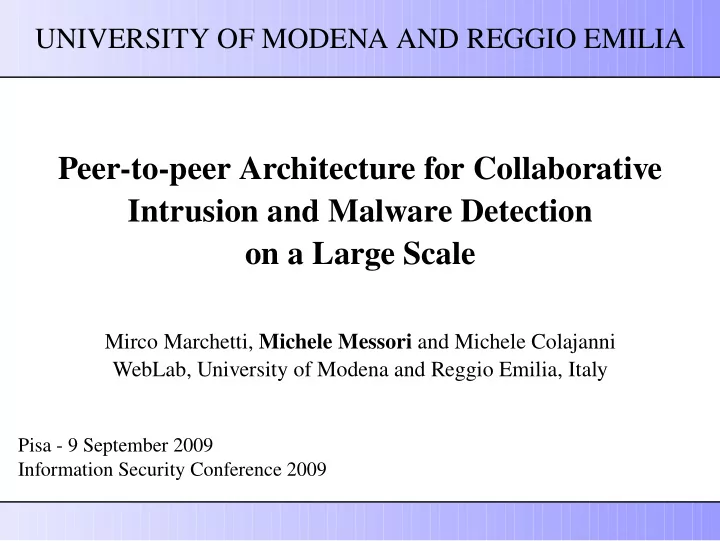

UNIVERSITY OF MODENA AND REGGIO EMILIA Peer-to-peer Architecture for Collaborative Intrusion and Malware Detection on a Large Scale Mirco Marchetti, Michele Messori and Michele Colajanni WebLab, University of Modena and Reggio Emilia, Italy Pisa - 9 September 2009 Information Security Conference 2009
Defense scenarios ● Complex information systems - Heterogenous networks (wired-wireless) - Networks consisting of multiple segments ● Cooperation among multiple organizations => Centralized defensive solutions do not work => Our focus: distributed architectures where cooperation is carried out through p2p schemes 2 P2P Architecture for Collaborative Intrusion and Malware Detection
Goals Building high-level activity reports from low-level alerts (related to one peer) about: ● Malware behavior ● Malware diffusion ● Network-based attacks ● Diffusion of intrusions ● Identification of suspicious IP addresses ● Identification of the servers from which the malware is downloaded ● ... 3 P2P Architecture for Collaborative Intrusion and Malware Detection
Distributed IDS model Main components (Heterogeneous) analyzers : ● Watch of host activities ● Sniffing of network traffic ● Interaction with (probable) attacker ● Stateful analysis of gathered data Collectors : ● Collection of low-level alerts from the analyzers Collaborator module : ● Aggregation and correlation of the alerts 4 P2P Architecture for Collaborative Intrusion and Malware Detection
Distributed IDS Existing architectures Centralized processing : ● Distributed analyzers ● Centralized aggregation Hierarchical processing : ● Distributed analyzers ● Multi-level hierarchical aggregation Common drawbacks: ● Single point(s) of failure ● Load unbalance ● Poor or fair scalability 5 P2P Architecture for Collaborative Intrusion and Malware Detection
Distributed IDS architecture based on P2P 6 P2P Architecture for Collaborative Intrusion and Malware Detection
Structure of a single node 7 P2P Architecture for Collaborative Intrusion and Malware Detection
Structure of a single node 8 P2P Architecture for Collaborative Intrusion and Malware Detection
Analyzer layer Main features: ● Intrusion detection ● Malware collection Analyzer types: ● Host IDS ● Network IDS ● Honeypot ● Sensor Manager 9 P2P Architecture for Collaborative Intrusion and Malware Detection
Local aggregation layer Main features: ● Pre-processing of all collected data for homogeneous storage ● Classification and storage of all alerts in the local alert database 10 P2P Architecture for Collaborative Intrusion and Malware Detection
Collaboration layer Main features: ● Submits collected alerts to the DHT-based overlay network ● Manages a portion of the hash space ● Disseminates the analysis results 11 P2P Architecture for Collaborative Intrusion and Malware Detection
Operations: Early detection 1)Collecting alerts from analyzers 2)Extrapolating information 3)Keys selection 4)Messages distribution based on hash key ( , , ) 5)Real-time creation of the replicas 6)Automatic management of the replicas 12 P2P Architecture for Collaborative Intrusion and Malware Detection
Operations: Key selection One message submitted for every interesting field, such as: ● Malware’s binary code ( ) ● IP address of the server from which the malware has been downloaded ( ) ● IDS signature ID ● IP address of the attacker ( ) 13 P2P Architecture for Collaborative Intrusion and Malware Detection
Operations: Early warning 7) Processing received messages 8) Broadcast communication of analysis results (high level activity reports )( ) 9) Early warning threats 10) All peers are protected 14 P2P Architecture for Collaborative Intrusion and Malware Detection
Prototype Components Analyzers: ● OSSEC (HostIDS) ● Snort (NetworkIDS) ● Nepenthes (Honeypot) Collector: ● Prelude (Hybrid IDS) – useful for IDMEF ● MySql (DBMS) Collaboration module: ● Freepastry libraries (DHT overlay) 15 P2P Architecture for Collaborative Intrusion and Malware Detection
Prototype Present features ● Key generation for different alert fields ● Management of malware bincode ● Anomaly detection threshold-based ● Emulation of thousands of nodes through Freepastry libraries 16 P2P Architecture for Collaborative Intrusion and Malware Detection
Fault Tolerance – graceful degradation 17 P2P Architecture for Collaborative Intrusion and Malware Detection
Simulation results Fault tolerance Concurrent k=4 k=5 k=6 faults (%) 1 0.009 0 0 2 0.16 0.003 0 3 0.735 0.019 0.001 4 2.117 0.075 0.002 5 5.022 0.219 0.015 6 9.732 0.542 0.037 7 16.64 1.186 0.081 8 25.859 2.172 0.159 9 36.682 3.774 0.315 10 48.685 5.904 0.529 Message loss probability for a network of 10,000 nodes and for different replica factor k. Values in percentage (%) 18 P2P Architecture for Collaborative Intrusion and Malware Detection
Conclusions and future work Conclusions ● Load balancing (as in Indra) ● Graceful degradation (as in Domino) ● Interoperability with heterogeneous sensors/analyzers ● Malware payload management ● Prototype Future works ● To enhance anomaly detection (e.g., new aggregation algorithms) ● Malware analysis (through internal engine or external services ) 19 P2P Architecture for Collaborative Intrusion and Malware Detection
Recommend
More recommend